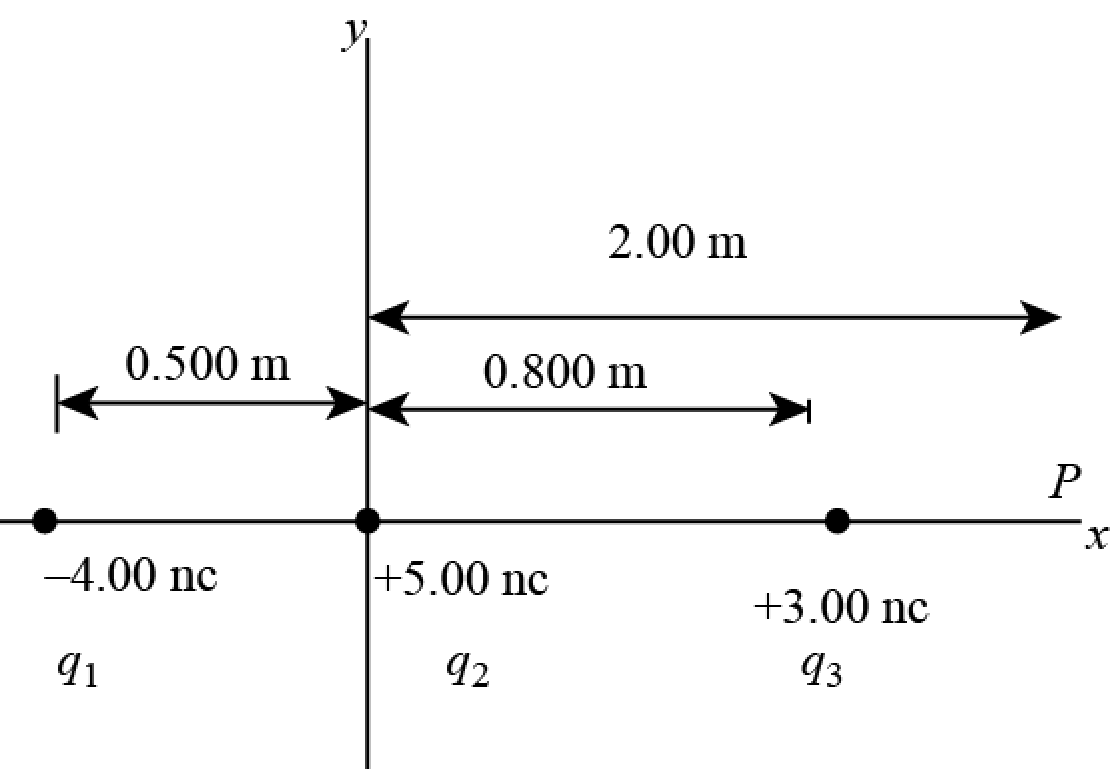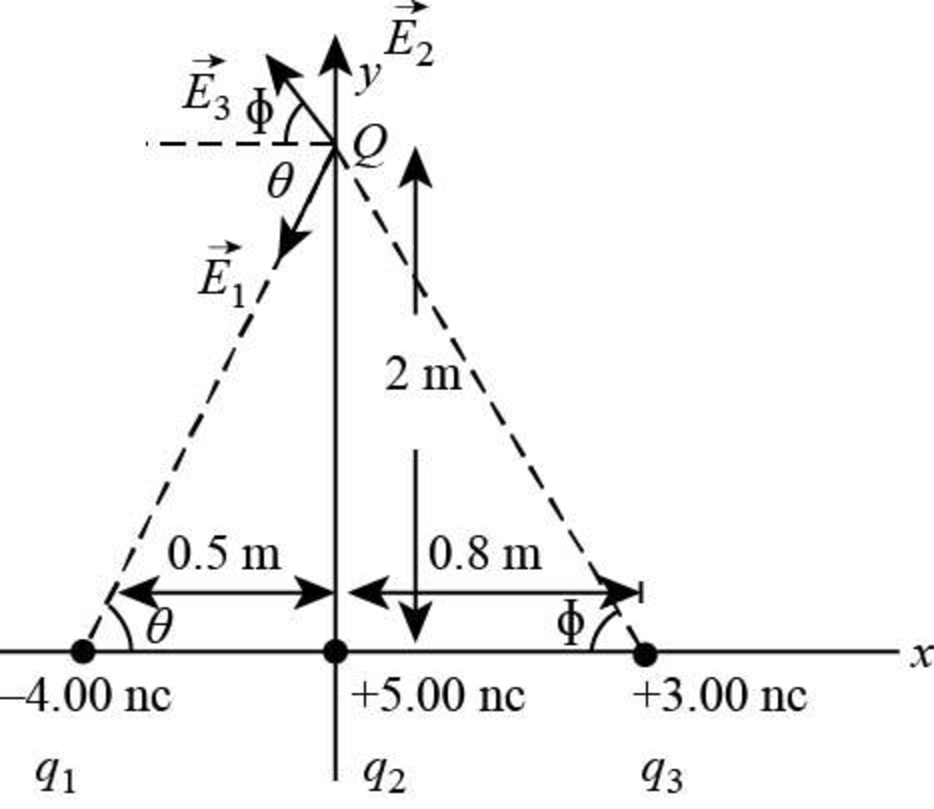
Concept explainers
Three charged particles are aligned along the x axis as shown in Figure P22.35. Find the electric field at (a) the position (2.00 m, 0) and (b) the position (0, 2.00 m).
Figure P22.35

(a)
The electric field at the position
Answer to Problem 23.69AP
The electric field at the position
Explanation of Solution
Three charges are acting on the same line along the
According to Coulomb’s law, write the expression for the electric field created by a charge
Here,
The electric field at a point due to number of charges is resultant of the electric field due to the individual charges.
The figure for the position of point charges is shown below.

Figure (1)
Write the expression for the electric field due to charge
Here,
Substitute
Write the expression for the electric field due to charge
Here,
Substitute
Write the expression for the electric field due to charge
Here,
Substitute
Write the expression for the resultant electric field
Here,
Conclusion:
Substitute
Thus, the electric field at position
(b)
The electric field at the position
Answer to Problem 23.69AP
The electric field at the position
Explanation of Solution
Three charges are acting on the same line along the
The figure for the position of point charges is shown below,

Figure (2)
According to Pythagoras theorem, the distance between the charge
Here,
According to Pythagoras theorem, the distance between the charge
Here,
Write the expression for the electric field due to charge
Here,
Substitute
In component form the electric field can be written as,
According to right angle triangle property,
And,
Substitute
Write the expression for the electric field due to charge
Here,
Substitute
Write the expression for the electric field due to charge
Here,
Substitute
In component form the electric field can be written as,
According to right angle triangle property,
And,
Substitute
Write the expression for the resultant electric field
Here,
Conclusion:
Substitute
Therefore, the electric field at position
Want to see more full solutions like this?
Chapter 23 Solutions
Physics for Scientists and Engineers, Technology Update (No access codes included)
- aA plastic rod of length = 24.0 cm is uniformly charged with a total charge of +12.0 C. The rod is formed into a semicircle with its center at the origin of the xy plane (Fig. P24.34). What are the magnitude and direction of the electric field at the origin? Figure P24.34arrow_forwardA charged cork ball of mass 1.00 g is suspended on a light string in the presence of a uniform electric field as shown in Figure P22.33. When E=(3.00i+5.00j)105N/C, the ball is in equilibrium at = 37.0. Find (a) the charge on the ball and (b) the tension in the string. Figure P22.33 Problems 33 and 34arrow_forwardA charged cork ball of mass m is suspended on a light string in the presence of a uniform electric field as shown in Figure P22.33. When E=Ai+Bj, where A and B are positive quantities, the ball is in equilibrium at the angle . Find (a) the charge on the ball and (b) the tension in the string. Figure P22.33 Problems 33 and 34arrow_forward
- Find an expression for the magnitude of the electric field at point A mid-way between the two rings of radius R shown in Figure P24.30. The ring on the left has a uniform charge q1 and the ring on the right has a uniform charge q2. The rings are separated by distance d. Assume the positive x axis points to the right, through the center of the rings. FIGURE P24.30 Problems 30 and 31.arrow_forwardThree charged particles are aligned along the x axis as shown in Figure P22.35. Find the electric field at (a) the position (2.00 m, 0) and (b) the position (0, 2.00 m). Figure P22.35arrow_forwardTwo long, thin rods each have linear charge density = 6.0 C/m and lie parallel to each other, separated by 20.0 cm as shown in Figure P25.32. Determine the magnitude and direction of the net electric field at point P, a distance of 15.0 cm directly above the right rod. Figure P25.32arrow_forward
- Three identical charges (q = 5.0 C.) lie along a circle of radius 2.0 m at angles of 30, 150, and 270, as shown in Figure P15.33 (page 524). What is the resultant electric field at the center of the circle? Figure P15.33arrow_forwardThree identical charges (q = 5.0 C.) lie along a circle of radius 2.0 m at angles of 30, 150, and 270, as shown in Figure P15.33 (page 524). What is the resultant electric field at the center of the circle? Figure P15.33arrow_forwardA solid insulating sphere of radius a = 5.00 cm carries a net positive charge of Q = 3.00 C uniformly distributed throughout its volume. Concentric with this sphere is a conducting spherical shell with inner radius b = 10.0 cm and outer radius c = 15.0 cm as shown in Figure P24.54, having net charge q = 1.00 C Prepare a graph of the magnitude of the electric field due to this configuration versus r for O r 25.0 cm.arrow_forward
- A uniformly charged insulating rod of length 14.0 cm is bent into the shape of a semicircle as shown in Figure P23.45. The rod has a total charge of 7.50 C. Find (a) the magnitude and (b) the direction of the electric field at O, the center of the semicircle.arrow_forwardA circular ring of charge with radius b has total charge q uniformly distributed around it. What is the magnitude of the electric field at the center of the ring? (a) 0 (b) keq/b2 (c) keq2/b2 (d) keq2/b (e) none of those answersarrow_forwardIf the magnitude of the surface charge density of the plates in Figure P25.55 is = 99.5 nC/m2, what is the magnitude of the electric field between the plates? If an electron is placed between the plates, what is the magnitude of the electric force on it? FIGURE P25.55arrow_forward
 Physics for Scientists and Engineers with Modern ...PhysicsISBN:9781337553292Author:Raymond A. Serway, John W. JewettPublisher:Cengage Learning
Physics for Scientists and Engineers with Modern ...PhysicsISBN:9781337553292Author:Raymond A. Serway, John W. JewettPublisher:Cengage Learning Physics for Scientists and EngineersPhysicsISBN:9781337553278Author:Raymond A. Serway, John W. JewettPublisher:Cengage Learning
Physics for Scientists and EngineersPhysicsISBN:9781337553278Author:Raymond A. Serway, John W. JewettPublisher:Cengage Learning College PhysicsPhysicsISBN:9781305952300Author:Raymond A. Serway, Chris VuillePublisher:Cengage Learning
College PhysicsPhysicsISBN:9781305952300Author:Raymond A. Serway, Chris VuillePublisher:Cengage Learning College PhysicsPhysicsISBN:9781285737027Author:Raymond A. Serway, Chris VuillePublisher:Cengage Learning
College PhysicsPhysicsISBN:9781285737027Author:Raymond A. Serway, Chris VuillePublisher:Cengage Learning Physics for Scientists and Engineers: Foundations...PhysicsISBN:9781133939146Author:Katz, Debora M.Publisher:Cengage Learning
Physics for Scientists and Engineers: Foundations...PhysicsISBN:9781133939146Author:Katz, Debora M.Publisher:Cengage Learning Physics for Scientists and Engineers, Technology ...PhysicsISBN:9781305116399Author:Raymond A. Serway, John W. JewettPublisher:Cengage Learning
Physics for Scientists and Engineers, Technology ...PhysicsISBN:9781305116399Author:Raymond A. Serway, John W. JewettPublisher:Cengage Learning





